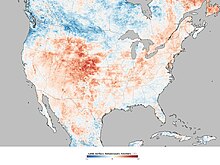 Map of land surface temperature anomalies for June 17–24, 2012. The map depicts temperatures compared to the 2000–2011 average for the same eight-day period in June. (Land surface temperatures (LST) are distinct from the hot air temperatures that meteorological stations typically measure.) | |
| Start date | mid June 2012 |
|---|---|
| End date | August 2012 |
| Peak temp. | 115 °F (46 °C) |
| Losses | |
| Deaths | 82 direct, 22 indirect |
| Damages | $30 billion (2012 USD)[1] |
The Summer 2012 North American heat wave was one of the most severe heat waves in modern North American history. It resulted in more than 82 heat-related deaths across the United States and Canada,[2][3] and an additional twenty-two people died in the resultant June 2012 North American derecho. This long-lived, straight-line wind and its thunderstorms cut electrical power to 3.7 million customers.[4] Over 500,000 were still without power on July 6, as the heat wave continued.[5] Temperatures generally decreased somewhat the week of July 9 in the east,[6] but the high pressure shifted to the west, causing the core of the hot weather to build in the Mountain States and the Southwestern United States shifting eastwards again by mid-July. By early August, the core of the heat remained over the Southern Plains.[7][8]
- ^ Extreme Weather and Climate Change, Center for Climate and Energy Solutions
- ^ "Americans get relief from heat, but severe storms loom". MSNBC. Associated Press. 2012-06-30. Archived from the original on 2012-07-15. Retrieved 2012-07-07.
- ^ Bruce Schreiner; Roxana Hegeman & Seth Borenstein (2012-06-28). "Nation bakes as serious heat wave hits early". Yahoo! News. Retrieved 2012-07-07.
- ^ Ian Simpson (2012-06-30). "Storms leave 3.4 million without power in eastern U.S." Chicago Tribune. Reuters. Archived from the original on 2012-07-03. Retrieved 2012-06-30.
- ^ "Over 115 million bake in heat, with more scorching temps to come". CNN.com. July 7, 2012. Retrieved 2012-07-07.
- ^ "US to get a reprieve from hot temperatures". The Wall Street Journal. Associated Press. 9 July 2012. Retrieved 30 July 2012.
- ^ Nelson, Laura J. (2012-07-07). "Heat relief is on way for East, Midwest, as high temps shift west". Los Angeles Times. Retrieved 2012-07-30.
- ^ "U.S. News | National News - Latest Headlines, Videos, Photos - ABC News". Abcnews.go.com. 2006-05-04. Archived from the original on July 12, 2012. Retrieved 2012-07-30.